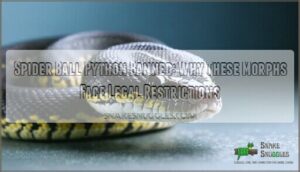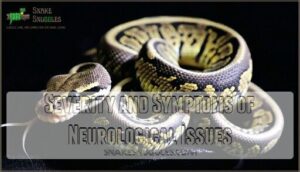This site is supported by our readers. We may earn a commission, at no cost to you, if you purchase through links.
 Spider ball pythons aren’t technically banned in most places, but you’ll face growing restrictions due to their genetic neurological disorder called "wobble syndrome." The International Herpetological Society banned their sale at expos in 2018, and many reptile shows now refuse spider morphs due to animal welfare concerns.
Spider ball pythons aren’t technically banned in most places, but you’ll face growing restrictions due to their genetic neurological disorder called "wobble syndrome." The International Herpetological Society banned their sale at expos in 2018, and many reptile shows now refuse spider morphs due to animal welfare concerns.
These snakes suffer from head tremors, balance problems, and spatial disorientation caused by inner ear malformations. While breeding remains legal in the US, the ethics of producing animals with guaranteed neurological defects continues sparking heated debates.
The controversy isn’t just about legality—it’s about whether profit justifies breeding suffering.
Table Of Contents
- Key Takeaways
- Why Are Spider Ball Pythons Controversial?
- Genetic Disorders in Spider Ball Pythons
- Animal Welfare Concerns and Industry Debate
- Legal Status and Bans on Spider Ball Pythons
- Scientific Research and Future of Spider Morphs
- Frequently Asked Questions (FAQs)
- Are spider ball pythons banned in the US?
- Why are spider ball pythons controversial?
- Are spider ball pythons venomous?
- What is the spider ball python mutation?
- Are there any health benefits to the spider gene?
- Can the wobble in spider ball pythons improve over time?
- What alternatives exist for spider ball python enthusiasts?
- Can spider ball pythons be shipped legally?
- What states ban spider ball python ownership?
- Do other python morphs have similar wobbles?
- Conclusion
Key Takeaways
- You won’t find spider ball pythons federally banned in the US, but you’ll encounter growing restrictions at reptile expos and shows due to animal welfare concerns about their genetic neurological disorder.
- You’re dealing with snakes that suffer from a guaranteed "wobble syndrome" – a genetic condition causing head tremors, balance problems, and feeding difficulties that can’t be cured or improved over time.
- You’ll see the International Herpetological Society banned their sale in 2018, and many major reptile shows now refuse spider morphs based on scientific evidence linking the spider gene to inner ear deformities.
- You can expect stricter regulations in the future as the reptile community increasingly prioritizes animal welfare over profits, with potential genetic testing requirements and expanded breeding restrictions coming.
Why Are Spider Ball Pythons Controversial?
You’ll encounter heated debates when discussing spider ball pythons because these snakes carry a genetic mutation that causes neurological disorders, including head tremors and balance problems.
The controversy centers on whether breeding animals with known genetic defects constitutes ethical animal husbandry practices.
Unique Appearance and Morph Popularity
Spider Ball Python morphs captivate you with their striking appearance. These Ball Python morphs display unique morph patterns featuring cream bodies with dark veining and distinctive fractal crowns.
Their color variations include golden "alien heads" and reduced web patterns. Snake genetics create these sought-after Spider Ball Python traits, making them popular in breeding trends and pet ownership circles among python enthusiasts.
Contribution to The Reptile Industry
Economic powerhouse meets ethical crossroads. You’re witnessing how Spider Ball Python breeding transformed reptile markets since 1999. These morphs drove Industry Growth through explosive demand, yet Animal Welfare Concerns now challenge traditional Ball Python Breeding practices.
- Economic Impact: Spider morphs generated millions in revenue for breeders worldwide
- Market Trends: Nearly every breeder stock includes spider variants due to consumer demand
- Breeder Ethics: Industry debates balancing profit margins against Breeder Responsibility standards
- Conservation Efforts: Some advocate redirecting focus toward wild-type preservation over designer morphs
Genetic Disorders in Spider Ball Pythons
When you’re considering spider ball pythons, you’ll encounter specific genetic disorders that directly affect their neurological function.
These inherited conditions cause observable symptoms including head tremors, balance issues, and spatial disorientation that can impact the snake’s daily activities.
The “Wobble” Syndrome Explained
Understanding wobble syndrome starts with recognizing it’s a genetic disorder affecting your Spider Ball Python’s central nervous system. This neurological condition causes head trembling and balance issues. Genetic research confirms inner ear abnormalities create these symptoms. You’ll notice wobble severity varies between individual snakes, making breeding ethics a complex topic.
| Wobble Characteristic | Normal Snake | Spider Ball Python |
|---|---|---|
| Head Movement | Stable, controlled | Trembling, unsteady |
| Balance | Excellent coordination | Impaired spatial awareness |
| Inner Ear Structure | Normal anatomy | Deformed, inflated canals |
| Feeding Behavior | Precise striking | Difficulty targeting |
| Stress Response | Minimal symptoms | Increased wobble intensity |
Severity and Symptoms of Neurological Issues
Neurological damage in Spider Ball Pythons manifests through distinct symptoms that affect daily functioning. You’ll observe balance issues causing unsteady movement and spatial awareness problems leading to disorientation.
Motor skills deteriorate, creating feeding difficulties as snakes struggle to strike accurately. Wobbly syndrome presents varying severity levels, from mild head tremors to pronounced corkscrewing motions affecting the entire body during stress or feeding attempts.
Impact on Quality of Life
Most Spider Ball Pythons suffering from Wobbly Syndrome face significant challenges in basic functions. Neurological effects create eating difficulties and spatial disorientation.
Animal suffering intensifies when snakes can’t strike prey accurately or maintain balance. Quality Care becomes demanding as owners must monitor feeding closely.
These Genetic Disorders compromise normal behaviors, making ethical breeding questionable under current welfare standards for reptile animal welfare.
Animal Welfare Concerns and Industry Debate
When you examine spider ball pythons, you’ll encounter a heated debate that splits the reptile community down the middle. Industry professionals continue to argue whether breeding these morphs constitutes ethical animal husbandry or perpetuates unnecessary neurological suffering.
Arguments Against Breeding Spider Ball Pythons
Advocates against breeding Spider Ball Python morphs cite compelling breeding ethics concerns. These genetic disorders cause neurological problems that compromise animal welfare throughout their lives.
Animal suffering becomes inevitable when you knowingly produce snakes with Wobbly Syndrome. Welfare priorities should outweigh aesthetic preferences, critics argue.
Conservation impact suffers when genetic risks become normalized in captive populations.
Arguments Supporting Continued Breeding
Supporters argue that responsible ownership and proper husbandry can minimize wobbly syndrome causes in Spider Ball Python breeding. They emphasize that breeding benefits include maintaining genetic diversity within reptile breeding programs.
The spider gene contributes significant economic impact to the industry. Proponents stress that genetic science continues advancing, potentially offering solutions while preserving conservation value.
Economic and Ethical Considerations
Balancing profit with animal welfare creates tension in reptile breeding practices. Market trends show spider morphs generate significant revenue, yet growing consumer awareness challenges traditional breeding ethics.
- Industry Impact: Spider bans affect breeder income and market stability
- Consumer Rights: Buyers deserve transparency about neurological disorders
- Animal Rights Movement: Advocates push for stricter trade regulations
- Breeder Ethics: Some prioritize profits over animal welfare concerns
- Reptile Ban Legislation: Emerging laws reshape breeding practices nationwide
Legal Status and Bans on Spider Ball Pythons
You’ll find that spider ball pythons face restrictions at specific reptile expos and shows, though they remain legal to breed and sell in most jurisdictions.
The International Herpetological Society banned their sale in 2018, citing animal welfare concerns related to the neurological disorder affecting these morphs.
Expos and Event Restrictions
Across the reptile community, you’ll find Event Bans increasingly targeting Spider Ball Python sales at major exhibitions. Show Policies now reflect growing Snake Welfare concerns, with Breeder Restrictions limiting vendors who sell these morphs.
Exhibition Rules prioritize Reptile Care standards, responding to the Animal Rights Movement’s pressure regarding Neurological Issues in these snakes.
International Herpetological Society Ban
The International Herpetological Society dropped the hammer in 2018, banning Spider Ball Python sales at their shows. This Society Ethics decision sparked fierce debate over Python Welfare versus Breeder Rights.
The IHS’s Regulatory Impact targeted three problematic morphs:
- Spider Ball Python (for Spider gene-linked Neurological Issues)
- Jaguar Carpet Pythons (similar Wobble symptoms)
- Enigma Leopard Geckos (comparable genetic problems)
This Ban Enforcement triggered heated arguments online. The decision prioritized animal welfare over breeding profits, marking a landmark moment in Reptile Genetics regulation.
Current Legal Status in Different Regions
Regional legality for Spider Ball Python ownership varies widely. Private ownership remains legal federally in the US, but expo restrictions and breeding regulations increase annually. Import/export laws in Australia completely ban ball pythons, while European breeders face growing animal welfare pressures.
Online sales continue despite neurological issues debates among reptile genetics communities. Reptile owners must research state reptile laws to verify compliance with local regulations.
Scientific Research and Future of Spider Morphs
You’ll discover how recent genetic studies have transformed our understanding of spider ball python neurological disorders.
The 2022 research by Starck et al. established a direct connection between the spider gene and abnormal inner ear development, providing concrete scientific evidence for breeding regulation discussions.
2022 Genetic Study Findings
Recent scientific research has illuminated the genetic mutation underlying Spider Ball Python neurological issues. The 2022 Starck et al. study used μCT imaging and morphology analysis to compare inner ear structure in spider morphs versus wild-type pythons. Their pivotal findings revealed distinct malformations in every spider specimen examined.
- All spider morph snakes exhibited wobble syndrome with anatomical abnormalities in semicircular canals and sacculus
- Distinctive structural differences were identified between spider and wild-type ball pythons using state-of-the-art imaging techniques
- Considerable variability exists between individuals, explaining different symptom severity levels in affected animals
This research establishes the genetic linkage between the spider gene and neurological impacts, providing concrete evidence for ongoing welfare debates. The study’s research implications fundamentally changed how we perceive wobble syndrome’s biological basis. Further analysis of the technical connection issues can provide more insights into the genetic mutation.
Link Between Morph and Inner Ear Anatomy
Scientists uncovered the smoking gun behind wobble syndrome: anatomical abnormalities in the inner ear structure. Spider ball python morphs show distinct malformations affecting their stato-acoustic organs. Comparative studies revealed that spider morphs have neural-crest associated developmental malformations of the saccular and semicircular canals. These neurological links between morph genetics and ear anatomy confirm that genetic mutation causes neurological disorders in affected pythons.
Scientists confirmed that spider ball pythons suffer from inner ear deformities that directly cause their neurological wobble syndrome
| Anatomical Structure | Wild Type | Spider Morph |
|---|---|---|
| Semicircular Canals | Normal diameter | Wider cross-section |
| Sacculus | Standard formation | Smaller, deformed |
Potential for Future Breeding Regulations
Genetic Testing and Breeding Restrictions may reshape Royal Python Breeding in the coming years. As wobble syndrome research strengthens, breeders face potential regulatory frameworks targeting Neurological Disorders.
Animal Welfare Laws could expand to include specific Conservation Policies, while genetic screening may become mandatory for Spider Ball Python reproduction, fundamentally altering current breeding practices.
Frequently Asked Questions (FAQs)
Are spider ball pythons banned in the US?
Spider ball pythons aren’t federally banned in the US, but you’ll face restrictions. No state or federal laws prevent breeding them , though some reptile expos have banned their sale due to neurological concerns.
Why are spider ball pythons controversial?
You’ll encounter heated debates because spider ball pythons carry a genetic defect causing neurological issues called "wobble syndrome." This affects their balance, coordination, and quality of life, sparking ethical concerns.
Are spider ball pythons venomous?
No, spider ball pythons aren’t venomous. Ball pythons are nonvenomous constrictors that squeeze prey instead of using venom.
You’ll find they’re generally docile pets, though their bites can still cause bacterial infections requiring medical attention.
What is the spider ball python mutation?
You’ll encounter a dominant genetic trait causing distinctive web-like patterns on ball pythons. This mutation inevitably triggers wobble syndrome, a neurological disorder affecting balance and coordination with varying severity levels.
Are there any health benefits to the spider gene?
No, you won’t find health benefits from the spider gene. Research confirms it causes neurological disorders including head wobble and spatial awareness issues, with no documented positive effects.
Can the wobble in spider ball pythons improve over time?
Unfortunately, you can’t cure the wobble—it’s like trying to fix a broken mirror. The neurological condition remains stable throughout your snake’s life, neither improving nor worsening predictably over time.
What alternatives exist for spider ball python enthusiasts?
You can explore similar-looking morphs like champagne, pinstripe, or lesser ball pythons that offer striking patterns without neurological issues.
These alternatives provide beautiful aesthetics while ensuring your snake’s wellbeing remains uncompromised.
Can spider ball pythons be shipped legally?
Yes, you can legally ship these pythons interstate in most U.S. states. It’s 100% legal to order a ball python from one state & have it shipped to another.
Check your specific state regulations beforehand.
What states ban spider ball python ownership?
No states specifically ban spider ball python ownership. There are no state or federal laws that prevent you from breeding them.
However, New York City limits ban the selling and owning of all python species. Check local regulations.
Do other python morphs have similar wobbles?
Like cracks in a foundation revealing structural flaws, wobble syndrome affects other python morphs too. Champagne, Hidden Gene Woma, and Power Ball morphs also exhibit neurological issues, though you’ll find Spider morphs most severely affected.
Conclusion
The scales of justice weigh heavily against spider ball pythons as scientific evidence mounts. Genetic research linking neurological disorders to breeding practices strengthens regulatory arguments.
You’ll witness continued restrictions as more expos ban these morphs based on welfare concerns. While the spider ball python banned debate continues, the reptile community increasingly prioritizes animal welfare over aesthetic appeal.
Expect stricter oversight and more thorough breeding restrictions across jurisdictions. The future likely holds significant changes for these morphs.
- https://www.morphmarket.com/morphpedia/ball-pythons/spider/
- https://reptilesandresearch.org/articles/the-science-behind-why-spider-ball-pythons-wobble-whats-really-going-on
- https://www.aussiepythons.com/threads/spider-ball-python-ban.223972/
- https://pmc.ncbi.nlm.nih.gov/articles/PMC9377635/
- https://www.reddit.com/r/ballpython/comments/thbtg2/new_research_spider_ball_pythons_show/














